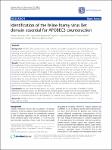Identification of the feline foamy virus Bet domain essential for APOBEC3 counteraction
Lukic, Dragana Slavkovic
Hotz-Wagenblatt, Agnes
Lei, Janet
Räthe, Ann-Mareen
Mühle, Michael
Denner, Joachim
Münk, Carsten
Löchelt, Martin
Background: APOBEC3 (A3) proteins restrict viral replication by cytidine deamination of viral DNA genomes and impairing reverse transcription and integration. To escape this restriction, lentiviruses have evolved the viral infectivity factor (Vif), which binds A3 proteins and targets them for proteolytic degradation. In contrast, foamy viruses (FVs) encode Bet proteins that allow replication in the presence of A3, apparently by A3 binding and/or sequestration, thus preventing A3 packaging into virions and subsequent restriction. Due to a long-lasting FV-host coevolution, Bet proteins mainly counteract restriction by A3s from their cognate or highly related host species. Results: Through bioinformatics, we identified conserved motifs in Bet, all localized in the bel2 exon. In line with the localization of these conserved motifs within bel2, this part of feline FV (FFV) Bet has been shown to be essential for feline A3 (feA3) inactivation and feA3 protein binding. To study the function of the Bet motifs in detail, we analyzed the ability of targeted deletion, substitution, and chimeric FFV-PFV (prototype FV) Bet mutants to physically bind and/or inactivate feA3. Binding of Bet to feA3Z2b is sensitive to mutations in the first three conserved motifs and N- and C-terminal deletions and substitutions across almost the complete bel2 coding sequence. In contrast, the Bel1 (also designated Tas) domain of Bet is dispensable for basal feA3Z2b inactivation and binding but mainly increases the steady state level of Bet. Studies with PFV Bel1 and full-length FFV Bel2 chimeras confirmed the importance of Bel2 for A3 inactivation indicating that Bel1 is dispensable for basal feA3Z2b inactivation and binding but increases Bet stability. Moreover, the bel1/tas exon may be required for expression of a fully functional Bet protein from a spliced transcript. Conclusions: We show that the Bel2 domain of FV Bet is essential for the inactivation of APOBEC3 cytidine deaminase restriction factors. The Bel1/Tas domain increases protein stability and can be exchanged by related sequence. Since feA3 binding and inactivation by Bet are highly correlated, the data support the view that FV Bet prevents A3-mediated restriction of viral replication by creating strong complexes with these proteins.
Dateien zu dieser Publikation
Keine Lizenzangabe

